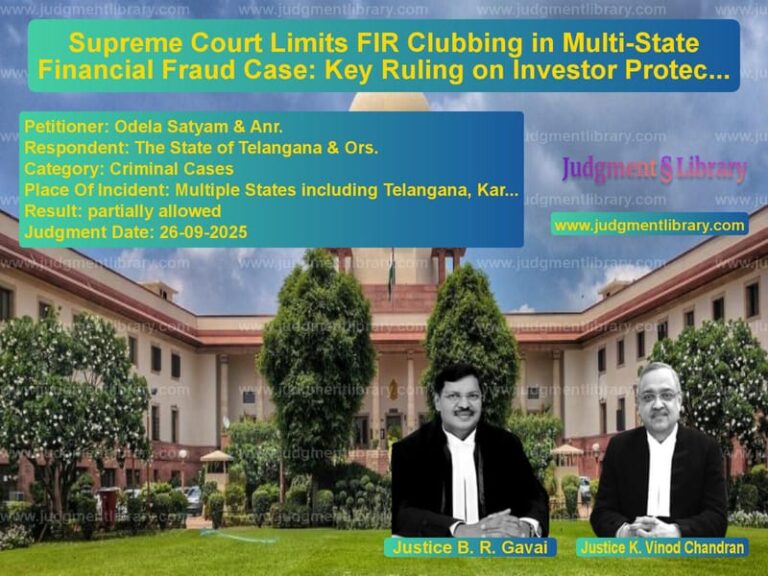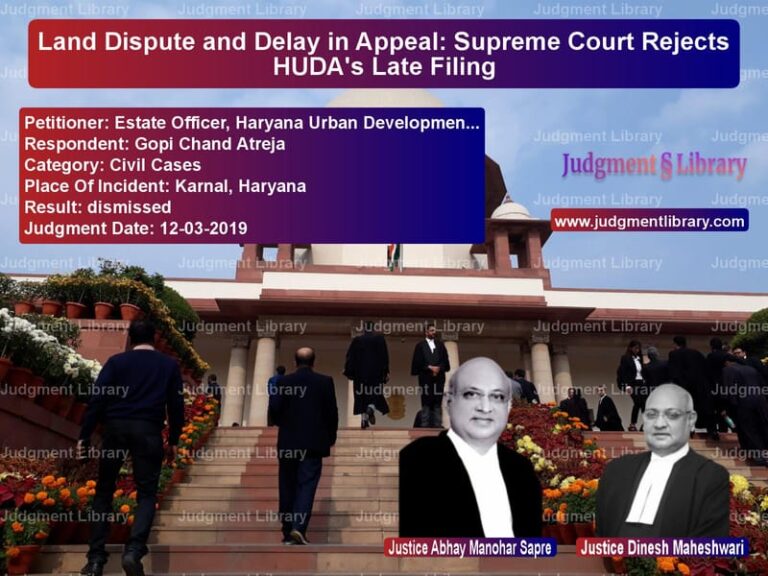Partition Dispute Resolved Through Mediation: Supreme Court Judgment in Narayana Pillai vs. Sivasankara Pillai
The case of Narayana Pillai Ramanpillai & Another vs. Sivasankara Pillai (Deceased) Through LRS & Others revolved around a family partition dispute that was ultimately resolved through mediation. The Supreme Court of India, recognizing the value of alternative dispute resolution mechanisms, referred the parties to the Kerala Mediation Centre, where they reached an amicable settlement. This case highlights the growing importance of mediation in resolving property disputes and setting precedents for future cases.
Background of the Case
The appellants, Narayana Pillai Ramanpillai and another, approached the Supreme Court seeking relief in a partition dispute. The parties had longstanding disagreements regarding the division of ancestral property, leading to prolonged litigation. The matter had initially been adjudicated in lower courts, and upon reaching the Supreme Court, the bench recommended mediation to explore a mutually acceptable resolution.
Supreme Court’s Referral to Mediation
On February 15, 2016, the Supreme Court directed the parties to participate in mediation at the Kerala Mediation Centre, an institution attached to the High Court of Kerala. The purpose of this referral was to facilitate a resolution that would be equitable to all concerned parties without requiring a prolonged legal battle.
Arguments by the Appellants
The appellants contended that:
- They had rightful claims over specific portions of the disputed property.
- The legal and factual aspects of the case supported their claims for a more favorable partition.
- The High Court’s previous rulings did not adequately address their concerns.
- A court-mandated settlement would be preferable to an uncertain and protracted legal dispute.
Arguments by the Respondents
The respondents, representing the heirs of the deceased Sivasankara Pillai, countered the appellants’ arguments with the following points:
- The property division should follow the principles of equitable distribution.
- The legal status of certain portions of the property had already been settled in prior proceedings.
- A settlement through mediation would be the most appropriate way to bring an end to the prolonged dispute.
Mediation Outcome
The mediation process facilitated by the Kerala Mediation Centre was successful, and the parties arrived at a Memorandum of Settlement on June 18, 2016. The settlement included:
- An agreement on the specific division of the property.
- A mutually accepted sketch of the partitioned property.
- Clauses ensuring that no further litigation would arise on the same issue.
Supreme Court’s Observations
Upon reviewing the settlement, the Supreme Court noted:
“We are happy to note that the parties have settled their disputes amicably pursuant to the mediation before the Kerala Mediation Centre and the Memorandum of Settlement has been produced in writing.”
The Court emphasized the benefits of mediation in family disputes, stating:
“Mediation provides an effective, speedy, and amicable resolution that courts may not always be able to achieve through litigation.”
Final Judgment
The Supreme Court passed the following orders:
- The appeal was disposed of in terms of the Memorandum of Settlement dated June 18, 2016.
- The agreed-upon sketch of the partition was made part of the Court’s judgment.
- The parties were bound by the terms of the settlement, ensuring no further litigation on the same matter.
Implications of the Judgment
The ruling in this case has several important implications:
- Encouragement for Mediation: The case demonstrates the judiciary’s support for alternative dispute resolution, especially in family and property matters.
- Time and Cost Savings: Mediation allowed the parties to resolve their dispute more quickly and efficiently than conventional litigation.
- Legally Binding Settlements: The Supreme Court’s order ensured that the terms agreed upon during mediation would be enforceable.
- Setting a Precedent: This case serves as an example for other families dealing with partition disputes to consider mediation before resorting to prolonged litigation.
Conclusion
The Supreme Court’s decision in Narayana Pillai Ramanpillai vs. Sivasankara Pillai underscores the effectiveness of mediation in resolving partition disputes. By successfully facilitating a fair and amicable settlement, the Court reinforced the importance of alternative dispute resolution mechanisms. This case highlights the benefits of negotiated settlements over adversarial litigation, ensuring a more harmonious resolution for all parties involved.
Don’t miss out on the full details! Download the complete judgment in PDF format below and gain valuable insights instantly!
Download Judgment: Narayana Pillai Rama vs Sivasankara Pillai ( Supreme Court of India Judgment Dated 12-08-2016-1741878577134.pdf
Direct Downlaod Judgment: Direct downlaod this Judgment
See all petitions in Property Disputes
See all petitions in Succession and Wills
See all petitions in Landlord-Tenant Disputes
See all petitions in Judgment by Kurian Joseph
See all petitions in Judgment by Rohinton Fali Nariman
See all petitions in settled
See all petitions in settled
See all petitions in supreme court of India judgments August 2016
See all petitions in 2016 judgments
See all posts in Civil Cases Category
See all allowed petitions in Civil Cases Category
See all Dismissed petitions in Civil Cases Category
See all partially allowed petitions in Civil Cases Category







